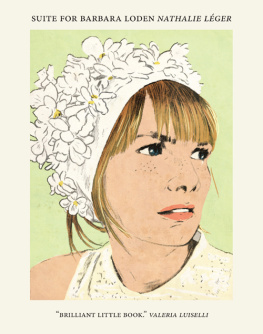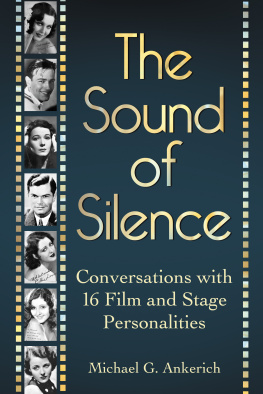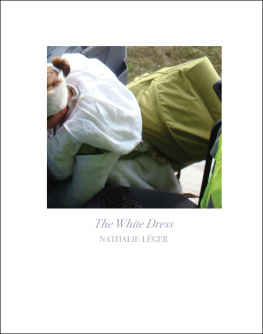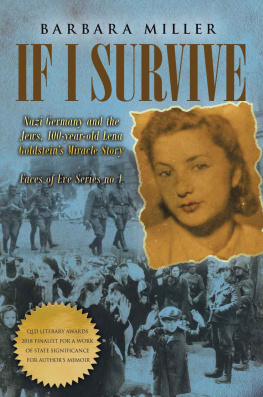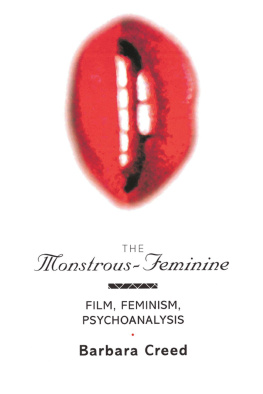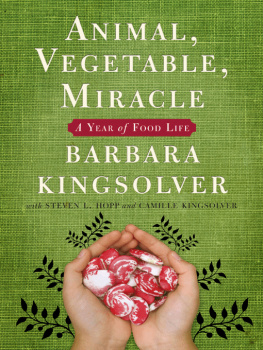Suite for Barbara Loden
Originally published in French as Supplment la vie de Barbara Loden in 2012 by ditions P.O.L., Paris, France
Copyright ditions P.O.L., 2012
Translation Les Fugitives, 2015
First U.S. edition, 2016
All rights reserved, including the right of reproduction in whole or in part in any form. This book is a work of fiction. Names, characters, places, and incidents either are products of the authors imagination or are used fictitiously.
The author is grateful to the French Institute for the Programme des Missions Stendhal grant, which enabled her to write this book.
The publisher wishes to thank Christina Wood Martinez & Stephen Sparks.
REFERENCES
Kate Chopin, The Awakening and Other Stories , Oxford World Classics, 2008 Elia Kazan, A Life , New York, Knopf, 1988
W.G. Sebald, The Rings of Saturn , trans. Michael Hulse, London, Vintage Classics, 2002
ISBN: 978-0-9973666-0-0
Ebook ISBN: 978-0-9973666-1-7
Art on cover: Wanda, mixed media Ruth Gwily, 2005
Design and composition by Danielle Dutton
Printed on permanent, durable, acid-free recycled paper in the United States of America
Dorothy, a publishing project
DOROTHYPROJECT.COM
Suite for Barbara Loden
Nathalie Lger

TRANSLATED FROM THE FRENCH
BY NATASHA LEHRER AND CCILE MENON
What about this one, is it too transparent, or not transparent enough?
It depends on whether you want to show the truth .
What does the truth look like?
Its between appearing and disappearing .
Jean-Luc Godard , Detective
SEEN FROM A DISTANCE, a woman, etched against the darkness. Whether it is a woman, in fact, is hard to tell, were so far away. Framed by mountains of rubble, a tiny white figure, barely more than a dot against the dark expanse, slowly and steadily picks its way through this huge mass of debris: a vast, towering slagheap, intersected with great mounds of excavated rock, stony depressions, muddy tracks waiting to be ploughed up by the trucks. In a wide-angle shot, we follow this minute, ethereal figure as it makes its way intently along the forbidding horizon. At times the dust absorbs and dissolves the figure as it doggedly moves on, lit up for a moment, now just a vague, blurry smudge, now almost transparent, like a backlit hole in the picture, a blind spot on the decimated landscape. Yes, it is a woman.
Earlier we saw her sitting at the back of an empty bus, gazing out but seeing nothing, and we heard her name, twice, as though it were being flung, Wanda, Wanda , a mans voice, casting over the story a muted, anxious question, the only time he utters her name.
We are inside the house now, we see the meagerly furnished rooms, things left lying about, an old woman sitting in the back holding a rosary, her face yellow in the pale streaky light, gaze fixed hard on something that disappeared long ago. We pan back a little; a child is running around her. We pan back further and see a woman from behind, shes wearing a nightdress, her disheveled hair is pinned up, her weary shoulders droop we think this must be her, this must be the heroine. We pan back further still, there is a baby on a bed, crying. We glide toward the dimly lit kitchen, she has taken the infant in her arms, we wonder where she will find milk, she moves slowly, sighs, opens the refrigerator, moves some dishes out of the way, vaguely tries to calm the cries. A man suddenly appears, the father presumably; he passes through, muttering, exits. We follow him; the door slams as we see a body stretched out under a sheet, a blonde woman, about thirty, slowly emerging. There are hair curlers and drink cans on the floor by the couch. She sits up, still half-asleep, Hes mad because Im here , she looks out of the window, the forbidding horizon is choked up to the sky, trucks are maneuvering in the dust. Its her, its Wanda.
The American actress and director Barbara Loden told this womans story in the 1970 film Wanda , the only film she ever directed and in which she also played the leading role. Barbara Loden is Wanda, as they say in the movies. Her inspiration for the screenplay was a newspaper story she had read about a woman convicted of robbing a bank; her accomplice was dead and she appeared in court alone. Sentenced to twenty years in prison, she thanked the judge. Interviewed when the film came out, after it had been awarded the International Critics Award at the 1970 Venice Film Festival, Barbara would say how deeply affected she had been by the story of this womanwhat pain, what hopelessness could make a person desire to be put away? How could imprisonment be relief?
A woman appears from within the folds of grimy bed-sheets, she seems unwilling to be forsaking sleep, waking up only to sink into the aggravating solidity of existencewhat has she been dreaming of? Of bright faces, the quiet calm of an orderly bedroom, some gesture of recognition, infinitely repeated? She sits up, confused. Everything is slipping away, everything escapes her; from now on she will just wander, lost among the shadows.
It seemed simple enough. All I had to do was write a short entry for a film encyclopedia. No need to put your heart and soul into it, the editor had said on the phone. This time I was very sure of myself. Convinced that in order to keep it short you need to know a great deal, I immersed myself in the history of the United States, read through the history of the self-portrait from antiquity to modern times, digressing to take in some sociological research about women from the 1950s and 1960s. I eagerly consulted dictionaries and biographies, gathered information about cinma vrit , artistic avant-garde movements, the New York theater scene, Polish immigration to the United States; I did research into coal mining (reading up about mining exploration, finding out about the organizational structure of the mining industry, collecting data on coal deposits in Pennsylvania); I knew everything there was to know about the invention of hair curlers and the rise of the pin-up model after the war. I felt like I was managing a huge building site, from which I was going to excavate a miniature model of modernity, reduced to its simplest, most complex form: a woman telling her own story through that of another woman.
So whats the story about? my mother had enquired. She was pretending to be interested just to be nice, but she didnt care. She really wanted to go back to ordinary stories of ordinary lives, gossip, things she knew and cared abouta dead cousin, an ailing female friend, a sickly child; and no sooner had she asked the question than my mind went blank, a fog set in, I felt a sudden unfamiliarity with the subject: everything that had been clear and obvious suddenly seemed completely inconsequential, lost in the awful echo chamber of background noise as she absentmindedly scraped her spoon around the bottom of her almost empty coffee cup, waiting for me to begin. Its the story of a woman who is alone. Ah. The story of a woman. Yes? The story of a woman who has lost something important but doesnt know exactly what, her children, her husband, her life, something else perhaps but we dont know what, a woman who leaves her husband, her children, who breaks upbut without violence, without having thought about it, without even wanting to break up. And? And nothing. Nothing happens? Not really. Well, yes: she meets a man, follows him, gets attached to him even though he mistreats her, perhaps because he mistreats her, we dont know, in any case she stays, shes there, she stays. Right. Hes planning to rob a bank but his accomplice pulls out and he forces her to replace himbut thats not the point. The heist goes badly wrong, he diesbut thats not the point. Silence descended between us. I waited for her to ask me what the point was, but she didnt.

